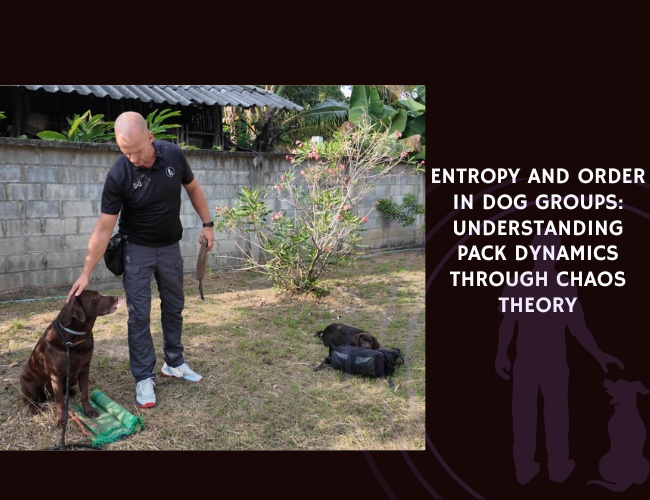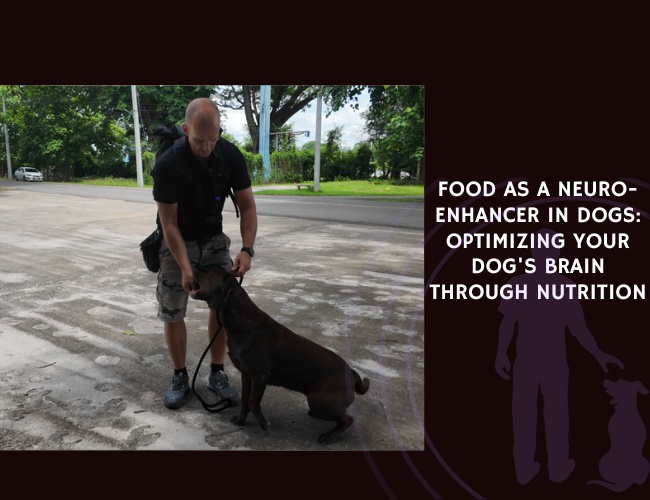Introduction
Have you ever wondered why your usually calm companion suddenly develops anxiety, or why that once-eager learner seems to struggle with focus during training sessions? The answer might not lie in your training methods or your dog’s personality—it could be hiding in their food bowl. Welcome to the fascinating world of micronutrient psychiatry for dogs, where tiny minerals create massive impacts on your furry friend’s mental health and behavior.
For centuries, we’ve understood that proper nutrition keeps our dogs physically healthy, but only recently have we begun to uncover the profound connection between micronutrients and canine mental well-being. Just as a magnesium deficiency might leave you feeling anxious and restless, your dog’s behavioral challenges could stem from similar nutritional imbalances. This isn’t just about keeping their coat shiny or their bones strong—it’s about nurturing their emotional resilience, cognitive sharpness, and overall quality of life.
Today, let us guide you through the intricate pathways connecting your dog’s diet to their behavior, exploring how minerals like magnesium, zinc, iron, and selenium act as invisible conductors orchestrating everything from stress responses to learning abilities. You’ll discover why that reactive behavior at the dog park or those separation anxiety episodes might have roots deeper than training alone can address.
Character & Behavior: The Micronutrient Foundation
Understanding Your Dog’s Neurochemical Orchestra
Your dog’s behavior isn’t just a product of training and genetics—it’s a complex symphony conducted by neurochemicals, with micronutrients playing the role of essential instruments. When we observe our dogs, we’re actually witnessing the external expression of countless internal chemical reactions, each influenced by the availability of specific minerals and vitamins.
The Big Players in Behavioral Balance: Think of your dog’s brain as a sophisticated communication network where neurotransmitters like serotonin (the happiness messenger), dopamine (the reward signal), and GABA (the calming force) constantly relay messages. Without adequate micronutrients, these messengers can’t do their jobs properly. Magnesium, for instance, acts as a natural relaxant by supporting GABA function—when it’s low, your normally easy-going companion might become the neighborhood’s most anxious barker.
Zinc’s Role in Emotional Regulation: Research reveals that zinc deficiency creates a domino effect in the brain, disrupting the hypothalamic-pituitary-adrenal (HPA) axis—your dog’s central stress management system. This disruption doesn’t just make your dog “a bit stressed”; it fundamentally alters how they perceive and respond to their environment. A dog with inadequate zinc might interpret a friendly visitor as a threat, not because they’re naturally aggressive, but because their brain’s threat assessment system is chemically compromised.
The Selenium Shield: Meanwhile, selenium works behind the scenes as your dog’s neural bodyguard. Its powerful antioxidant properties protect delicate brain cells from oxidative stress—the cellular equivalent of rust. Without this protection, neurons become damaged, leading to cognitive decline, increased anxiety, and even depression-like symptoms. You might notice your senior dog becoming more anxious or your young pup struggling with focus during training—both could signal selenium’s absence from their neural protection team. 🧠
Vocalization & Communication: When Minerals Affect How Your Dog “Talks”
Decoding the Nutritional Language of Barks and Whines
Every bark, whine, and growl tells a story, but did you know that micronutrient imbalances can completely rewrite your dog’s communication script? When essential minerals are missing, your dog’s ability to express themselves appropriately becomes compromised, leading to excessive vocalization or, conversely, unusual silence.
Magnesium and the Anxious Voice: Dogs with magnesium deficiency often develop what we call “reactive vocalization”—that piercing, repetitive barking that seems to come from nowhere. This isn’t your dog being difficult; it’s their nervous system crying out for nutritional support. The GABAergic system, which normally keeps excitability in check, can’t function properly without magnesium. The result? Your dog might bark at shadows, react explosively to doorbell sounds, or engage in prolonged howling episodes that leave both of you exhausted.
Iron’s Impact on Energy and Expression: Iron deficiency creates a different communication challenge altogether. This essential mineral supports oxygen transport to the brain, and without it, your dog might become lethargic and less responsive. You might notice they’ve stopped their morning greeting routine or no longer “talk back” during playtime. This silence isn’t contentment—it’s the brain conserving energy because it lacks the resources for normal expression.
Reading the Biochemical Signals: Pay attention to changes in your dog’s vocalization patterns. Has your typically quiet companion become increasingly vocal? Or has your chatty friend grown unexpectedly silent? These shifts often coincide with dietary changes, stress periods, or age-related absorption issues that affect micronutrient availability. Understanding this connection empowers you to address the root cause rather than simply managing the symptoms. 🐾
Training & Education: Optimizing the Learning Brain
Fueling Focus and Memory Through Micronutrition
Imagine trying to learn a new language while suffering from brain fog—that’s what training feels like for a micronutrient-deficient dog. The cognitive machinery required for learning, memory formation, and impulse control depends heavily on an intricate balance of minerals that many dogs simply aren’t getting enough of.
Zinc: The Memory Mineral: Recent studies in animal cognition reveal that zinc plays a crucial role in synaptic plasticity—the brain’s ability to form new connections during learning. When zinc levels drop, your dog’s capacity to remember commands, navigate familiar routes, or even recognize regular visitors becomes impaired. That “stubborn” behavior during training sessions? It might actually be your dog’s brain struggling to encode new information without adequate zinc support.
Iron and Attention Span: Iron deficiency manifests distinctly in training contexts through shortened attention spans and increased distractibility. The prefrontal cortex, your dog’s executive control center, requires iron-dependent enzymes to maintain focus and process complex commands. Without sufficient iron, even simple tasks like “stay” become monumentally challenging, not due to disobedience but because the brain literally cannot maintain the sustained attention required.
Selenium’s Protective Role in Aging Learners: For our senior dogs, selenium becomes increasingly critical for maintaining cognitive function. Its antioxidant properties protect against age-related neural damage, preserving the ability to learn new routines even in later years. Senior dogs with optimal selenium levels show remarkable resilience in adapting to changes—whether it’s a new home layout or modified training exercises for their aging bodies.
Creating the Optimal Learning Environment: Consider implementing what we call “nutritional priming” before training sessions. This doesn’t mean stuffing your dog with supplements, but rather ensuring their regular diet provides steady micronutrient support. Morning training sessions often yield better results when preceded by a nutrient-rich breakfast, as this provides the brain with immediate resources for cognitive tasks. Remember, you’re not just training behaviors—you’re nourishing the biological systems that make learning possible.
Performance & Activities: Athletic Excellence Through Mineral Balance
From Agility Courses to Daily Walks—The Micronutrient Advantage
Whether your dog is a competitive athlete or a casual park visitor, their physical performance directly reflects their micronutrient status. These minerals don’t just support muscles and bones; they orchestrate the complex neurological processes that coordinate movement, maintain endurance, and enable recovery.
Magnesium: The Performance Enhancer: Think of magnesium as your dog’s natural performance enhancer. It regulates muscle contractions, prevents cramping, and supports energy production at the cellular level. Dogs involved in agility, flyball, or even enthusiastic fetch sessions require higher magnesium levels to maintain peak performance. You might notice a magnesium-deficient dog experiencing muscle tremors after exercise, struggling with coordination during jumps, or showing unusual fatigue during previously manageable activities.
Iron’s Oxygen Delivery System: For working dogs—whether they’re herding sheep or accompanying you on mountain hikes—iron becomes absolutely critical. This mineral enables red blood cells to carry oxygen to working muscles and the brain. Iron-deficient dogs often show decreased stamina, rapid breathing during mild exercise, and extended recovery times. That Border Collie who used to work tirelessly might start taking frequent breaks, not from laziness but from cellular oxygen starvation.
Zinc and Injury Recovery: Athletes know that recovery is where gains are made, and the same applies to our canine companions. Zinc accelerates wound healing, reduces inflammation, and supports protein synthesis for muscle repair. Dogs with adequate zinc bounce back quickly from intense activities, while deficient dogs might develop chronic soreness or recurring minor injuries that never quite heal properly.
The Selenium Stress Buffer: Intense physical activity generates oxidative stress—essentially, cellular wear and tear. Selenium acts as your dog’s internal recovery team, neutralizing harmful free radicals that accumulate during exercise. This becomes especially important for dogs in demanding roles like search and rescue, police work, or competitive sports where repeated high-intensity efforts are required. 🧡
Nutritional Recommendations: Building a Brain-Healthy Diet
The Practical Guide to Micronutrient Optimization
Understanding the theory is one thing, but how do you actually ensure your dog receives optimal micronutrient support? Let’s explore practical strategies that go beyond simply choosing a “complete and balanced” commercial food.
Assessing Your Current Feeding Strategy: Start by honestly evaluating what your dog currently eats. Many commercial diets meet minimum requirements but may not provide optimal levels for behavioral and cognitive health. Factors like processing methods, storage duration, and ingredient quality all affect micronutrient availability. That premium kibble might list impressive mineral content, but if those minerals aren’t in bioavailable forms, your dog’s body can’t utilize them effectively.
Natural Sources vs. Supplementation: Whenever possible, prioritize whole food sources of micronutrients. Zinc-rich options include grass-fed beef, lamb, and pumpkin seeds (ground for digestibility). Magnesium abounds in fish, leafy greens (lightly steamed), and quinoa. Iron comes from organ meats, sardines, and egg yolks. Selenium is found in Brazil nuts (use sparingly), fish, and eggs. These whole food sources provide cofactors and complementary nutrients that enhance absorption—something isolated supplements can’t match.
Strategic Supplementation Timing: If supplementation becomes necessary—perhaps due to a diagnosed deficiency or increased needs from stress or athletic performance—timing matters tremendously. Fat-soluble minerals absorb better with meals containing healthy fats. Avoid giving zinc and iron together, as they compete for absorption. Magnesium works best given in the evening, supporting overnight recovery and promoting calm sleep.
Age and Life Stage Considerations: Puppies experiencing rapid brain development need higher levels of zinc and iron for optimal cognitive development. Adult dogs in stressful situations (new homes, training programs, or breeding) benefit from increased magnesium and selenium. Senior dogs often require enhanced supplementation due to decreased absorption efficiency, with particular attention to selenium for cognitive preservation and zinc for immune support.
Monitoring and Adjusting: Watch for subtle changes that indicate improving micronutrient status: increased focus during training, calmer responses to triggers, improved recovery from exercise, and more appropriate vocalization patterns. Keep a behavior journal noting changes after dietary modifications—this provides invaluable feedback for fine-tuning your approach.

Health Concerns: When Deficiencies Become Disorders
Recognizing and Addressing Micronutrient-Related Behavioral Issues
The line between a behavioral problem and a nutritional deficiency isn’t always clear, but understanding the connection can transform how we approach our dogs’ mental health challenges. Let’s explore how specific deficiencies manifest as behavioral disorders and what steps you can take to address them.
The Anxiety-Magnesium Connection: Chronic anxiety in dogs often stems from magnesium deficiency, creating a vicious cycle where stress depletes magnesium stores, which increases anxiety, leading to further depletion. Signs include excessive panting without physical exertion, destructive behavior when alone, hypervigilance (constantly scanning for threats), inability to settle even in familiar environments, and exaggerated startle responses. These dogs aren’t “neurotic” by nature—they’re experiencing the biochemical consequences of mineral inadequacy.
Depression and Zinc Deficiency: Canine depression, while less discussed than anxiety, affects countless dogs and frequently correlates with zinc deficiency. You might observe loss of interest in previously enjoyed activities, decreased appetite despite no physical illness, excessive sleeping or lethargy, reduced social interaction with family members, and what we call “learned helplessness”—giving up quickly when faced with challenges. These symptoms mirror human depression linked to zinc deficiency, highlighting the cross-species importance of this mineral for emotional well-being.
Cognitive Dysfunction and Selenium: Senior dogs developing cognitive dysfunction syndrome (similar to human dementia) often show severely depleted selenium levels. Early signs include disorientation in familiar spaces, disrupted sleep-wake cycles, inappropriate elimination despite house training, failure to recognize family members, and getting “stuck” in corners or behind furniture. While age-related cognitive decline seems inevitable, optimizing selenium status can significantly slow progression and preserve quality of life.
The Compulsive Behavior-Iron Link: Repetitive, compulsive behaviors like excessive licking, tail chasing, or shadow chasing frequently accompany iron deficiency anemia. The brain, deprived of adequate oxygen, triggers these behaviors as a coping mechanism. Additional signs include pale gums, exercise intolerance, rapid breathing, and unusual cravings (eating dirt or licking metal objects—actually attempts at self-medicating the deficiency).
Integrated Treatment Approaches: Address these conditions through what we call “nutritional psychiatry”—combining dietary optimization with behavioral modification. This means correcting deficiencies through diet and appropriate supplementation, implementing stress-reduction strategies to prevent nutrient depletion, working with a veterinary behaviorist who understands nutritional factors, and maintaining consistent routines that support both behavioral and nutritional stability. Remember, medication might still be necessary for severe cases, but optimizing micronutrient status often reduces dosage requirements and improves treatment outcomes. 🐾
Lifestyle & Environment: Creating a Micronutrient-Supportive Life
Environmental Factors That Influence Nutritional Status
Your dog’s environment profoundly impacts their ability to absorb and utilize micronutrients. Understanding these interactions helps you create living conditions that support optimal nutritional status and, consequently, better behavior and emotional health.
Stress: The Nutrient Thief: Chronic stress doesn’t just affect your dog’s mood—it literally steals their micronutrients. The stress response depletes magnesium reserves, increases zinc excretion, impairs iron absorption, and accelerates selenium consumption through increased oxidative stress. Common stressors include frequent household changes, inconsistent routines, noise pollution (construction, traffic), social stress from incompatible housemates, and even your own stress, which dogs readily absorb.
Water Quality and Mineral Absorption: The water your dog drinks affects mineral balance more than most people realize. Extremely soft water lacks beneficial minerals, while very hard water can interfere with absorption of dietary minerals. Consider having your water tested and potentially using filtered water that maintains beneficial mineral content while removing contaminants. Some dogs benefit from adding a pinch of pink Himalayan salt to their water, providing trace minerals in naturally balanced proportions.
Exercise and Micronutrient Demands: Physical activity increases micronutrient requirements, but the type and intensity matter significantly. High-intensity activities rapidly deplete magnesium and increase oxidative stress (demanding more selenium). Endurance activities require sustained iron for oxygen transport. Mental work (training, puzzle toys) particularly taxes zinc reserves. Balance your dog’s activity level with appropriate nutritional support, increasing micronutrient availability on high-demand days.
Gut Health: The Absorption Gateway: Even the best diet fails if your dog’s gut can’t absorb nutrients properly. Factors affecting gut health and mineral absorption include antibiotic use (disrupts beneficial bacteria essential for mineral processing), inflammatory bowel conditions (damage absorption sites), food sensitivities (create chronic inflammation), and inadequate dietary fiber (necessary for mineral chelation). Supporting gut health through probiotics, prebiotics, and digestive enzymes enhances micronutrient absorption naturally.
Seasonal Considerations: Micronutrient needs fluctuate seasonally, something wild canids naturally address through dietary variation. During winter, dogs require more magnesium for thermoregulation and selenium for immune support. Summer increases zinc needs due to higher stress and activity levels. Spring and fall transitions stress the body, depleting multiple minerals simultaneously. Adjust supplementation seasonally, mimicking nature’s wisdom about cyclical nutritional needs.
Breed-Specific Predispositions: Tailoring Nutrition to Genetic Needs
Understanding Your Breed’s Unique Micronutrient Blueprint
Not all dogs are created equal when it comes to micronutrient needs. Centuries of selective breeding haven’t just shaped our dogs’ appearances—they’ve created distinct metabolic patterns, stress responses, and nutritional requirements that directly impact behavior and mental health. Understanding your breed’s specific vulnerabilities empowers you to prevent deficiencies before they manifest as behavioral problems.
Working and Herding Breeds: The High-Performance Engines Border Collies, Australian Shepherds, German Shepherds, and Belgian Malinois represent the Formula One cars of the dog world—high-performance machines requiring premium fuel. These breeds typically need 20-30% more magnesium than average dogs due to their intense mental and physical activity levels. Their constantly firing neurons, whether herding sheep or mastering agility courses, rapidly deplete magnesium stores. You might notice these breeds developing obsessive behaviors, inability to settle, or reactive responses when magnesium runs low. Additionally, their high-stress work creates oxidative damage requiring increased selenium support—up to double the standard requirements during peak working periods.
Giant Breeds: Building and Maintaining Massive Frameworks Great Danes, Mastiffs, Saint Bernards, and Newfoundlands face unique challenges that extend beyond their impressive size. Their rapid growth phases demand extraordinary zinc levels—sometimes 40% above standard recommendations—to support proper bone development and joint health. Zinc deficiency in these gentle giants often manifests as anxiety around stairs or reluctance to engage in normal play, mistakenly attributed to laziness rather than the discomfort of compromised joint function. Their massive hearts also require consistent iron support, as deficiency can lead to exercise intolerance that appears as behavioral stubbornness.
Northern and Spitz Breeds: Arctic Adaptations in Modern Homes Siberian Huskies, Alaskan Malamutes, Samoyeds, and Shiba Inus evolved in selenium-rich arctic environments where fish formed dietary staples. Their thyroid function particularly depends on selenium, with deficiencies triggering metabolic slowdowns that manifest as unexpected aggression, lethargy, or cognitive fog. These breeds often require 25-50% more selenium than other dogs, especially when living in selenium-poor geographical regions. Their thick coats and unique metabolism also increase zinc turnover, requiring consistent supplementation to maintain the emotional stability they’re known for.
Toy and Small Breeds: Mighty Metabolisms in Miniature Bodies Chihuahuas, Yorkshire Terriers, Maltese, and Pomeranians burn through nutrients at surprisingly rapid rates. Their hummingbird-like metabolisms create particular challenges with iron absorption and retention. These breeds often need more frequent, smaller mineral doses throughout the day rather than single large supplements. Their tendency toward hypoglycemia also affects mineral utilization—unstable blood sugar impairs the body’s ability to properly distribute and use micronutrients, creating a cascade of behavioral issues from trembling anxiety to unexpected aggression.
Anxiety-Prone Breeds: The Sensitive Souls Certain breeds carry genetic predispositions to anxiety that create accelerated mineral depletion. Breeds particularly vulnerable include:
- German Shepherds and Belgian Malinois: High alertness depletes magnesium rapidly, requiring 30% above standard doses during stressful periods
- Vizslas and Weimaraners: Velcro dogs whose separation anxiety exhausts zinc reserves, needing consistent supplementation for emotional stability
- Cavalier King Charles Spaniels: Genetic heart conditions increase magnesium needs while their sensitive nature depletes B-vitamins
- Border Collies and Australian Shepherds: Intelligence comes with overthinking, burning through zinc and magnesium during mental processing
- Cocker Spaniels: Prone to rage syndrome potentially linked to serotonin disruption from chronic zinc deficiency
Understanding these breed-specific needs transforms supplementation from guesswork to precision nutrition, addressing genetic vulnerabilities before they become behavioral problems.
Drug-Nutrient Interactions: Critical Safety Considerations
Navigating the Complex World of Medications and Minerals
If your dog takes any medications—whether for behavior, pain, allergies, or chronic conditions—you’re walking a nutritional tightrope that few veterinarians discuss. Drugs don’t just treat symptoms; they profoundly affect how your dog’s body absorbs, uses, and excretes vital micronutrients. Understanding these interactions could mean the difference between treatment success and mysterious behavioral deterioration.
Common Medications That Steal Minerals:
NSAIDs (Rimadyl, Previcox, Metacam): These pain relievers, while essential for managing discomfort, create a perfect storm of mineral depletion. They reduce stomach acid production (necessary for mineral ionization), increase magnesium excretion through kidneys, and impair iron absorption by affecting gut lining. Dogs on long-term NSAIDs often develop anxiety or cognitive changes attributed to age when actually resulting from drug-induced deficiencies. Combat this by giving minerals 4 hours apart from NSAIDs and increasing magnesium supplementation by 25%.
Antibiotics: The Gut Disruptors: Every course of antibiotics devastates the beneficial bacteria essential for mineral absorption. Specific concerns include:
- Tetracyclines: Bind to calcium, magnesium, iron, and zinc, making all unavailable
- Fluoroquinolones: Deplete magnesium and can cause severe deficiency
- Metronidazole: Disrupts B-vitamin synthesis, affecting all mineral metabolism
- Cephalosporins: Increase zinc excretion through kidneys
Always supplement with probiotics during and after antibiotic courses, and increase mineral supplementation by 30-40% for two weeks post-treatment.
Behavioral Medications and Mineral Interactions:
The irony of behavioral medications is that they can worsen the very nutritional deficiencies contributing to behavioral problems:
- Fluoxetine (Prozac): Increases magnesium requirements by 40% and can deplete zinc
- Clomipramine (Clomicalm): Affects iron metabolism and reduces selenium absorption
- Trazodone: Depletes magnesium and B-vitamins, potentially worsening anxiety
- Gabapentin: Significantly reduces magnesium absorption, requiring supplementation timing adjustments
- Benzodiazepines: Increase zinc excretion and deplete magnesium stores
Strategic Timing Protocols: Maximize both medication effectiveness and mineral absorption with these timing strategies:
- Morning: Give thyroid medications alone, wait 1 hour before breakfast with iron supplements
- Mid-morning: Behavioral medications with small meal, avoiding calcium
- Afternoon: Zinc supplements, separated from iron by at least 2 hours
- Evening: Magnesium with dinner, at least 2 hours after any medications
- Bedtime: Selenium with small fat-containing snack for absorption
Dangerous Combinations to Avoid: Some supplement-medication combinations create serious risks:
- Never give calcium with thyroid medications (blocks absorption completely)
- Avoid iron supplements within 2 hours of antibiotics (mutual interference)
- Don’t combine high-dose zinc with NSAIDs (increased stomach irritation)
- Never give magnesium with quinolone antibiotics (dangerous interaction)
Tiny. Powerful. Essential.
Micronutrients orchestrate behavior. Minerals like magnesium, zinc, and selenium quietly shape how your dog processes stress, focus, and emotion. Without them, even small imbalances can ripple into major behavioral shifts.
Deficiencies distort perception. Low zinc or magnesium doesn’t just cause restlessness—it alters brain chemistry, turning safe situations into perceived threats and calm companions into anxious barkers.



Nutrition protects the mind. Selenium and other micronutrients act as shields against oxidative stress, preserving emotional balance and cognitive clarity. With the right support, your dog’s brain stays resilient and sharp.
Testing and Biomarkers: Your Diagnostic Roadmap
Getting Accurate Answers About Your Dog’s Mineral Status
You wouldn’t guess your dog’s weight—you’d use a scale. So why guess about their mineral status when accurate testing is available? Understanding which tests to request, how to interpret results, and when to retest transforms supplementation from hopeful experimentation to targeted intervention.
Essential Blood Tests to Request:
Comprehensive Mineral Panel: Ask specifically for these components (expect $200-400 total):
- Serum Magnesium: Standard test ($40-60) but only shows 1% of body stores
- RBC Magnesium: Better indicator ($60-80) reflecting cellular levels
- Serum Zinc: Baseline marker ($50-70) best drawn after 12-hour fast
- Ferritin: Superior to serum iron ($60-90) showing iron storage capacity
- Selenium: Whole blood test ($70-100) indicating long-term status
- Copper: Essential when supplementing zinc ($50-70) to maintain balance
Supporting Tests for Complete Picture:
- Complete Blood Count (CBC): Reveals anemia affecting behavior ($50-80)
- Comprehensive Metabolic Panel: Shows organ function affecting absorption ($80-120)
- Thyroid Panel: Critical for northern breeds ($100-150)
- B12 and Folate: Often depleted with mineral deficiencies ($80-100)
Understanding Reference Ranges: Laboratory “normal” ranges reflect average, not optimal. For behavioral health, aim for:
- Magnesium (RBC): Upper half of range (5.0-6.5 mg/dL)
- Zinc: Middle to upper range (0.7-1.2 mcg/mL)
- Ferritin: 50-150 ng/mL for small breeds, 80-200 for large
- Selenium: 150-250 mcg/L for optimal antioxidant function
Hair Mineral Analysis: Alternative or Addition? Hair testing offers different insights than blood work:
Advantages:
- Shows mineral status over 2-3 months (not just snapshot)
- Reveals toxic metal accumulation affecting mineral function
- Non-invasive collection at home
- Costs less ($100-150) than comprehensive blood work
Limitations:
- Results affected by external contamination (shampoos, environment)
- Doesn’t reflect acute deficiencies
- Interpretation requires experienced practitioner
- Not accepted by all veterinarians
Retesting Protocols:
- Initial deficiency: Retest after 8 weeks of supplementation
- Maintenance monitoring: Every 6 months for stable dogs
- Senior dogs: Quarterly testing due to changing absorption
- Dogs on medications: Every 3-4 months to adjust protocols
Insurance Coverage Tips: Most pet insurance covers testing when framed correctly:
- Request tests as part of “behavioral disorder workup”
- Document behavioral symptoms requiring investigation
- Have veterinarian note medical necessity for anxiety/aggression
- Submit with detailed clinical notes for better approval odds
Emergency Signs: When Deficiency Becomes Dangerous
Recognizing Critical Mineral Imbalances Requiring Immediate Action
While most mineral deficiencies develop gradually, certain situations create acute crises requiring emergency intervention. Knowing these warning signs could save your dog’s life and prevent permanent neurological damage.
Acute Magnesium Deficiency Crisis:
This medical emergency often follows severe stress, prolonged vomiting, or aggressive diuretic use:
Immediate veterinary care needed for:
- Seizures or seizure-like activity without known epilepsy
- Severe muscle tremors progressing to inability to stand
- Cardiac arrhythmias (irregular heartbeat you can feel)
- Extreme hyperesthesia (overreacting to any touch)
- Tetany (rigid, board-like muscle contractions)
Severe Iron Deficiency Anemia:
Beyond simple fatigue, acute iron deficiency becomes life-threatening:
Rush to emergency vet if you observe:
- Pale or white gums (should be bubble-gum pink)
- Collapse during mild exercise
- Rapid breathing at rest (over 30 breaths/minute)
- Eating non-food items obsessively (dirt, rocks, metal)
- Cold extremities with weak pulse
Zinc Deficiency Dermatosis:
While skin issues seem cosmetic, severe zinc deficiency affects entire body systems:
Requires immediate intervention:
- Crusty, scaling skin around eyes and mouth
- Hair loss in patches with underlying red, angry skin
- Difficulty eating due to mouth lesions
- Secondary infections from compromised immunity
- Behavioral changes including aggression from discomfort
Overdose Emergencies:
More isn’t always better—mineral overdoses create their own crises:
Iron Toxicity (most dangerous):
- Vomiting blood or bloody diarrhea within 6 hours of supplementation
- Abdominal pain (prayer position, reluctance to move)
- Progresses to liver failure within 24 hours
- Activated charcoal won’t help—need immediate chelation therapy
Zinc Overdose:
- Repeated vomiting starting 30 minutes after supplementation
- Lethargy progressing to depression
- Yellow tinge to gums or eyes (jaundice)
- Can cause fatal anemia if chronic
Distinguishing Behavioral from Medical:
Critical decision points for emergency vs. behavioral intervention:
- Sudden onset (hours to days) suggests medical emergency
- Progressive worsening despite intervention needs immediate care
- Multiple symptoms across systems indicates systemic problem
- Young or senior dogs have less reserve—err on side of caution
- Recent medication changes increase risk of acute imbalances
Never “Wait and See” With These Combinations:
- Seizures + any mineral supplementation = immediate ER
- Collapse + pale gums = immediate ER
- Bloody vomit/stool + iron supplements = immediate ER
- Extreme lethargy + recent zinc increase = immediate ER

Puppy Development: Building Behavioral Health from Birth
Critical Windows and Nutritional Foundations for Lifelong Stability
The first 16 weeks of your puppy’s life represent a neurological construction project of staggering complexity. During this period, micronutrients don’t just support growth—they literally build the architecture of your dog’s future temperament, learning capacity, and stress resilience. Missing these critical windows creates behavioral challenges that last a lifetime.
The Prenatal Foundation: Supporting Pregnant Mothers
Behavioral health begins before birth. Pregnant dogs experiencing micronutrient deficiencies produce puppies with:
- Increased anxiety tendencies from inadequate maternal magnesium
- Learning disabilities linked to maternal zinc deficiency
- Heightened stress reactivity from selenium-depleted development
- Aggression predispositions connected to iron-poor prenatal environments
Supporting the pregnant mother requires:
- 50% increased magnesium from week 5 of pregnancy
- 30% more zinc throughout gestation
- Double selenium needs in final trimester
- Careful iron monitoring (too much is toxic to developing puppies)
Birth to 4 Weeks: The Invisible Foundation
While puppies seem to just eat and sleep, massive neural development occurs:
During this phase, mineral needs spike for:
- Myelination: The insulation of nerve fibers requiring iron and zinc
- Neurotransmitter system establishment: Magnesium and B-vitamins critical
- Stress response programming: Selenium protecting developing systems
- Basic behavioral patterns: All minerals contributing to neural mapping
Nursing mothers need 2-3x normal mineral intake to meet milk production demands. Supplement mothers, not newborn puppies directly.
4-8 Weeks: The Socialization Mineral Surge
As puppies begin exploring and socializing, their brains undergo explosive growth requiring:
- Zinc surge: 40% above adult needs for rapid neural connections
- Magnesium stability: Preventing fear period intensification
- Iron increases: Supporting curiosity and exploration energy
- Selenium protection: Buffering stress of new experiences
Early weaning stress (before 8 weeks) depletes minerals rapidly, potentially creating lifelong anxiety. If early weaning is necessary, immediate supplementation becomes critical.
8-16 Weeks: The Learning Window
This famous socialization period coincides with peak mineral demands:
Critical supplementation priorities:
- Before vaccination visits: Extra magnesium prevents stress depletion
- During puppy classes: Zinc supports memory formation
- After stressful events: Selenium aids recovery
- Throughout fear periods: All minerals stabilize emotional responses
Preventing Deficiency from Day One:
Puppy-safe supplementation strategies:
- Start with food-based sources (easier on developing digestive systems)
- Divide supplements into 3-4 daily doses (puppy stomachs are small)
- Increase amounts gradually over weeks, not days
- Monitor stool quality—loose stools indicate too much too fast
Red Flags in Puppy Development: These signs suggest mineral deficiency requiring intervention:
- Excessive fearfulness during normal socialization
- Inability to recover from minor stresses
- Delayed learning of basic commands
- Unusual aggression toward littermates
- Persistent anxiety after transition to new home
- Poor growth despite adequate calories
Setting up puppies for behavioral success means thinking beyond house training and basic commands—it means nourishing the developing brain with precision during critical windows that never reopen. 🐾
Troubleshooting Guide: Solutions to Common Supplementation Challenges
Practical Fixes for Real-World Problems
Even with the best intentions, implementing a micronutrient protocol can hit unexpected snags. Here’s how to navigate the most common challenges without abandoning this crucial support for your dog’s behavioral health.
“My Dog Won’t Eat the Supplements”
The supplement struggle is real, but these strategies achieve success even with the pickiest eaters:
The Gradual Introduction Method: Start with 1/10th of the target dose mixed into their absolute favorite food. Increase by 10% every 3 days—slow enough that taste changes go unnoticed. Most dogs accept full doses within a month using this patience-testing but effective approach.
Creative Delivery Systems:
- Frozen treats: Mix supplements into plain yogurt, freeze in ice cube trays
- Meatball method: Hide supplements in center of homemade meatballs
- Bone broth slurry: Dissolve in warm broth, let cool, mix with food
- Pill pockets alternative: Cream cheese or peanut butter (xylitol-free)
- Liquid solutions: Often better accepted than powders or pills
Taste-Masking Champions:
- Sardines (covers zinc’s metallic taste)
- Nutritional yeast (masks magnesium bitterness)
- Coconut oil (helps with fat-soluble minerals)
- Raw honey (tiny amount masks most supplement tastes)
“We’re Not Seeing Improvements After 8 Weeks”
When patience runs thin, systematic troubleshooting reveals hidden obstacles:
Absorption Blockers to Investigate:
- Undiagnosed digestive issues preventing absorption
- Medications interfering with mineral utilization
- Wrong supplement forms (oxide vs. chelated forms)
- Timing conflicts with other nutrients or foods
- Inadequate stomach acid for mineral ionization
Increase Bioavailability:
- Add digestive enzymes with meals
- Include vitamin C for iron absorption
- Provide vitamin D for magnesium utilization
- Ensure adequate protein for mineral transport
- Consider liquid or liposomal forms
Hidden Depleters: Check for ongoing mineral thieves:
- Chronic stress continuing to drain reserves
- Untreated parasites affecting absorption
- Hidden food sensitivities causing gut inflammation
- Environmental toxins increasing mineral needs
- Excessive exercise depleting faster than replacing
“Multiple Dogs with Different Needs”
Managing a multi-dog household with varying supplement requirements requires strategy:
Feeding Station Solutions:
- Separate rooms: Each dog eats in designated space
- Timed feeders: Automatic feeders with individual supplements
- Height differentiation: Raised bowls for larger dogs
- Baby gates: Creating individual feeding zones
- Supervised supplementation: Treats given individually after meals
Customization Strategies:
- Base diet same for all, supplements added individually
- Color-coded bowls preventing mix-ups
- Supplement “cocktails” pre-mixed weekly per dog
- Calendar tracking who gets what when
- Consider all-in-one supplements for simpler dogs
“Traveling and Maintaining Supplementation”
Don’t let travel derail progress—plan ahead for continuity:
Pre-Travel Preparation:
- Pre-portion supplements in daily pill organizers
- Choose portable forms (liquids may leak)
- Research local pet stores at destination for emergencies
- Bring 3 days extra in case of travel delays
- Document regimen for pet sitters
Travel-Friendly Alternatives:
- Powder supplements (lighter than liquids)
- Chewable forms (no mixing required)
- Whole food sources when possible
- Temporary simplified protocol if needed
- Stress-support focus during travel
Boarding Considerations:
- Provide detailed written instructions
- Pre-mix supplements with treats
- Offer to pay extra for supplementation service
- Consider pet sitter at home instead
- Board at veterinary facilities more likely to comply
When Progress Stalls: Sometimes troubleshooting reveals the need for professional guidance:
- Consult veterinary nutritionist for complex cases
- Consider comprehensive testing for absorption disorders
- Evaluate for underlying conditions affecting metabolism
- Reassess whether behavioral issues have non-nutritional components
- Be patient—some dogs need 12-16 weeks for visible changes
Remember, every dog is unique. What works instantly for one might take months for another. The key is persistence, careful observation, and willingness to adjust approaches until you find what works for your individual companion.
Senior Care: Optimizing Golden Years Through Targeted Nutrition
Supporting Aging Brains and Bodies with Strategic Micronutrition
As our beloved companions age, their micronutrient needs don’t just change—they become more critical than ever for maintaining cognitive function, emotional stability, and quality of life. The senior years present unique challenges that targeted nutritional support can effectively address.
The Aging Brain’s Increased Demands: Senior dogs’ brains face a perfect storm of challenges: decreased nutrient absorption efficiency, increased oxidative stress, accumulation of cellular damage, reduced ability to synthesize certain compounds, and compromised blood-brain barrier function. These changes mean that even dogs eating the same diet that sustained them through adulthood may develop deficiencies. Selenium becomes particularly crucial, acting as the brain’s primary defender against age-related oxidative damage that contributes to cognitive dysfunction syndrome.
Addressing Age-Related Behavioral Changes: Many behaviors we attribute to “normal aging” actually stem from correctable micronutrient deficiencies. That increased anxiety during thunderstorms? Possibly magnesium depletion. The confusion about daily routines? Could indicate zinc insufficiency affecting memory consolidation. Unusual aggression or irritability? Often linked to iron-related oxygen deprivation in brain tissues. Understanding these connections transforms how we support our aging dogs, shifting from accepting decline to actively preserving function.
Absorption Challenges and Solutions: Senior dogs face multiple barriers to micronutrient absorption, including decreased stomach acid production (essential for mineral ionization), reduced digestive enzyme activity, changes in gut microbiome composition, and potential medication interactions. Combat these challenges by offering minerals in chelated forms (bound to amino acids for better absorption), dividing meals into smaller, more frequent portions, adding digestive enzymes to meals, and considering liquid or powdered supplements that don’t require breakdown.
The Synergy Approach: Rather than addressing minerals individually, senior dogs benefit from what we call “synergistic supplementation.” This means combining nutrients that enhance each other’s absorption and function. Vitamin C improves iron absorption while selenium and vitamin E work together as antioxidants. Magnesium and vitamin D support each other in maintaining cognitive function. Zinc and copper must be balanced carefully, as excess of one depletes the other. This orchestrated approach maximizes benefits while minimizing risks of imbalance.
Quality of Life Indicators: Monitor these aspects to gauge your senior dog’s micronutrient status: sleep quality (magnesium affects sleep architecture), social engagement (zinc influences social cognition), response to training (iron impacts learning ability), recovery from stress (selenium supports resilience), and general contentment (overall mineral balance affects mood). Improvements in these areas often occur within weeks of addressing deficiencies, offering our senior companions renewed vitality in their golden years. 🧡
Conclusion: Is Micronutrient Optimization Right for Your Dog?
Making Informed Decisions for Your Companion’s Mental Health
As we’ve explored throughout this journey into canine micronutrient psychiatry, the connection between what fills your dog’s bowl and what fills their emotional world runs deeper than traditional veterinary medicine has acknowledged. But understanding this connection is just the beginning—the real question is: how do you apply this knowledge to your unique companion?
Recognizing Your Dog’s Individual Needs: Every dog presents a unique nutritional puzzle. Your anxious rescue dog’s needs differ vastly from your neighbor’s senior Labrador or your friend’s high-drive Border Collie. Consider your dog’s life stage and developmental needs, current behavioral challenges or changes, activity level and working demands, stress exposure and environmental factors, existing health conditions, and genetic breed predispositions. These factors create your dog’s individual micronutrient blueprint—one that no generic feeding guide can fully address.
Taking the First Steps: Start your micronutrient optimization journey with observation and documentation. Create a baseline by recording current behaviors, energy levels, training responsiveness, and stress reactions. Then, examine your dog’s current diet critically—not just the label claims but the actual bioavailability of nutrients. Consider requesting comprehensive blood work including mineral panels from your veterinarian. This data provides the foundation for targeted intervention rather than guesswork.
The Integration Approach: Micronutrient optimization doesn’t replace behavioral training or veterinary care—it enhances them. Think of it as providing your dog’s brain with the raw materials needed to benefit from training, respond to behavioral modification, and maintain emotional equilibrium. Many dogs receiving behavioral medication show improved responses when micronutrient status is optimized, sometimes allowing for dosage reduction under veterinary supervision.
Your Next Steps Forward: If you recognize your dog in the descriptions of deficiency-related behaviors, don’t panic—but don’t delay either. Here’s your action plan:
Immediate steps (Week 1):
- Schedule a veterinary consultation specifically discussing nutritional factors in behavior
- Start a detailed behavior and diet journal noting patterns and changes
- Document current supplements and feeding routine completely
- Photograph your dog’s food labels for ingredient analysis
- Note any recent stressors or life changes
Assessment phase (Weeks 2-3):
- Request comprehensive blood work including mineral panels
- Discuss specific testing for zinc, iron, magnesium, and selenium levels
- Review current medications that might affect nutrient absorption
- Evaluate digestive health and gut function indicators
- Consider consultation with veterinary nutritionist
Implementation phase (Weeks 4-12):
- Begin dietary modifications based on test results
- Introduce whole food sources gradually to avoid digestive upset
- Monitor behavior changes weekly using your journal
- Adjust supplementation timing for optimal absorption
- Maintain consistent routine to support changes
Remember, addressing micronutrient imbalances is rarely instant—allow 6-8 weeks for noticeable behavioral changes after implementing dietary modifications.
The Promise of Nutritional Psychiatry: We stand at an exciting crossroads in canine behavioral health, where nutrition science meets neuroscience to offer hope for dogs struggling with anxiety, depression, cognitive decline, and other behavioral challenges. By embracing micronutrient optimization, you’re not just feeding your dog—you’re nourishing their capacity for joy, resilience, and connection.
The path forward isn’t always straightforward, and what works for one dog might need adjustment for another. But armed with knowledge about the profound impact of minerals like magnesium, zinc, iron, and selenium on your dog’s mental health, you’re equipped to make informed decisions that could transform your companion’s quality of life.
Remember, behind every behavioral challenge lies a complex interplay of genetics, environment, training, and—as we now understand—nutrition. By addressing all these factors, particularly the often-overlooked micronutrient component, you’re giving your dog the best chance at emotional well-being and behavioral balance.
Your dog depends on you to make these connections and take action. Whether it’s adding selenium-rich sardines to their diet, discussing magnesium supplementation with your vet, or simply being more mindful of how stress might be depleting their mineral reserves, every step toward optimization matters.
The journey toward optimal micronutrient status and improved behavior isn’t just about solving problems—it’s about unlocking your dog’s full potential for happiness, learning, and connection. And that journey starts with a single step: recognizing that what goes into their bowl shapes not just their body, but their entire emotional world. 🐾










